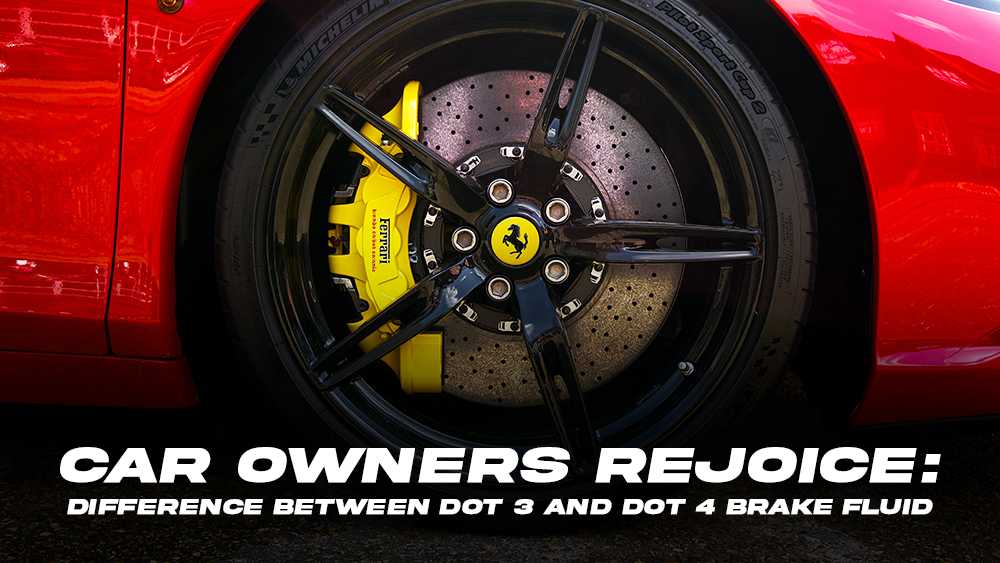
Brake fluid is an integral part of a car’s braking system, serving as a hydraulic fluid that transmits force from the brake pedal to the brake pads, allowing a car to stop effectively. There are different types of brake fluids available, but Dot 3 and Dot 4 are the most widely used.
It is important for car owners to know the difference between Dot 3 and Dot 4 brake fluid in order to maintain their vehicle’s safety and performance. While both types can perform similar functions, they have differing chemical compositions, boiling points, and viscosity levels. Understanding these differences is essential to ensure that the right type of brake fluid is used for each vehicle, as using the wrong type of fluid can compromise the effectiveness of the brakes. In this article, we will delve into the difference between Dot 3 and Dot 4 brake fluid to help car owners make informed decisions about maintaining their vehicle’s braking system.
Dot 3 vs. Dot 4 Brake Fluid: What’s the difference?
When it comes to maintaining a vehicle’s braking system, understanding the difference between Dot 3 and Dot 4 brake fluids is crucial. Both types of brake fluids are glycol-based and can be used in most cars, but they differ in their chemical composition, boiling points, viscosity, and compatibility with certain materials.
- Boiling Points
One of the most significant differences between Dot 3 and Dot 4 brake fluids is their boiling points. Dot 3 brake fluid has a lower boiling point than Dot 4, with a minimum boiling point of 401 °F (205 °C) compared to Dot 4’s minimum boiling point of 446 °F (230 °C). The higher boiling point of Dot 4 brake fluid means it is less likely to vaporize under high temperature and pressure conditions, making it a more suitable choice for performance-oriented vehicles and heavy-duty braking systems.
Using a brake fluid with a lower boiling point than recommended can result in a loss of brake performance, fade, and even brake failure in extreme cases. - Viscosity
Viscosity refers to the thickness of a fluid and its resistance to flow. Dot 3 brake fluid has a thinner consistency than Dot 4, meaning it flows more easily through the brake system. Dot 4 brake fluid is more viscous, providing a firmer brake pedal feel and improved performance in extreme driving conditions.
Using a brake fluid with a higher viscosity than recommended can lead to increased wear on brake system components, decreased brake performance, and difficulty in braking altogether. - Compatibility with Materials
Another important difference between Dot 3 and Dot 4 brake fluids is their compatibility with different materials in the car’s braking system. Dot 3 brake fluid is compatible with rubber components but may cause damage to certain plastics and painted surfaces. Dot 4 brake fluid is more compatible with a wider range of materials, including plastics and elastomers, making it a better choice for modern car models with complex braking systems
Using the wrong type of brake fluid can cause damage to the brake components, leading to leaks, reduced performance, and expensive repairs.
In summary, both Dot 3 and Dot 4 brake fluids have their pros and cons. Dot 3 brake fluid is a cost-effective and suitable option for most cars with standard brakes, while Dot 4 brake fluid provides better performance and safety benefits for vehicles with performance braking systems or exposed to extreme driving conditions. It is important to follow the manufacturer’s recommendations and use the right type of brake fluid for the specific car model, as using the wrong type of brake fluid can cause serious safety hazards and expensive repairs.
Which One Should You Use?
Choosing between Dot 3 and Dot 4 brake fluids depends on several factors, such as the car’s make and model, driving conditions, and personal preference. Here are some recommendations based on the most common scenarios:
- Standard Cars with Factory Brakes
For most cars with standard brakes, Dot 3 brake fluid is usually the manufacturer’s recommended choice. It is less expensive and meets the minimum regulatory standards for braking performance. - Heavy-Duty Vehicles and High-Performance Cars
Heavy-duty vehicles, such as trucks, SUVs, or high-performance cars, often require a brake system that can handle a higher stress level. Dot 4 brake fluid, with its higher boiling point, provides better performance and safety benefits for vehicles that are frequently driven under extreme conditions, such as mountainous terrain, towing, or high-speed driving. - Modern Cars with Complex Braking Systems
Modern car models may feature complex braking systems with different materials, such as plastics and elastomers, that require a brake fluid that is compatible with a wider range of materials. In these cases, Dot 4 brake fluid is usually the safer option.
Regardless of the car type, it’s important to check the owner’s manual or consult a professional mechanic to determine the recommended type of brake fluid for your specific vehicle.
Final Thoughts
In conclusion, brake fluid is a crucial component of a car’s braking system, and choosing the right type of brake fluid is essential for optimal safety and performance. While Dot 3 and Dot 4 brake fluids are both glycol-based and can be used in most cars, they differ in their chemical composition, boiling points, viscosity, and compatibility with certain materials.
It’s important to use the manufacturer-recommended type of brake fluid for your specific car model, as using the wrong type of brake fluid can cause serious safety hazards and expensive repairs. Regularly checking your car’s brake fluid levels and consulting a professional mechanic can help ensure the brakes are working efficiently, and prevent brake fade, loss of performance, and even brake failure.
In the end, investing in the right type of brake fluid can go a long way towards driving safely and smoothly on the road. Contact us today for more information.
